Don't wanna be here? Send us removal request.
Text
Nothing But Skimm
If you haven’t noticed I’ve been on news kick lately – and for good reason. I am part of the millennial generation, a group perceived to not have an awareness of the world. Completely untrue. Eighty-five percent of millennials say keeping up with the news is important to them and 69 percent get the news daily. The difference between us and previous generations is that we use nontraditional outlets as a source of our news. According to an American Press Institute survey, millennials not only get news from Facebook (at 86 percent), but also YouTube (at 83 percent) and Instagram (at 50 percent). [1]
I like most millennials enjoy getting news daily; I also like to have a quick summary that is delivered to me, accessible from my mobile and current. The founders of Skimm realized this need and capitalized on it in the 2008 recession turning a morning email news update into a successful news media corporation complete with a news email digest (Daily Skimm), social media presence and a mobile app that charges users $2.99 a month.
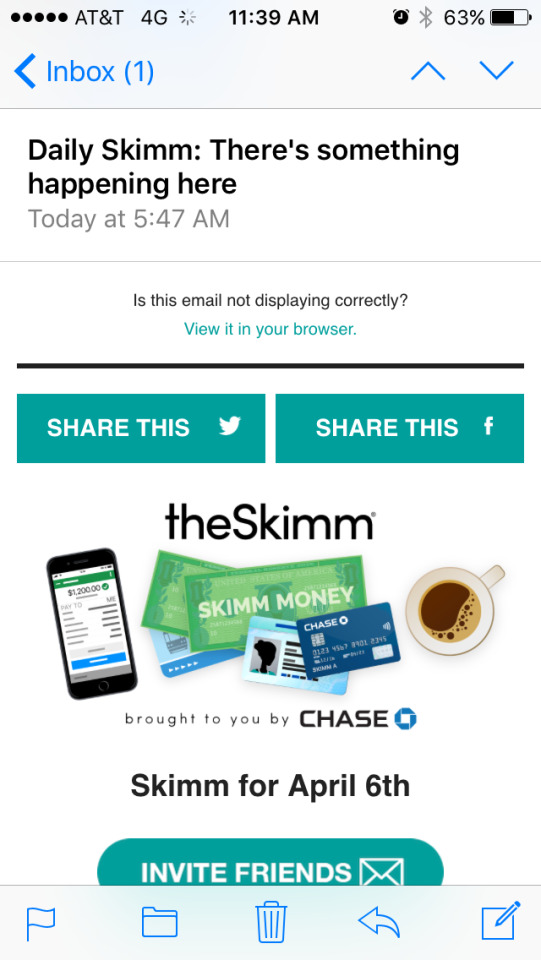
It is an all in one news source with everything from the latest in politics, ecommerce and events happening that day. They provide an update on calendar events to look for, as well as the high level of what you need to know.
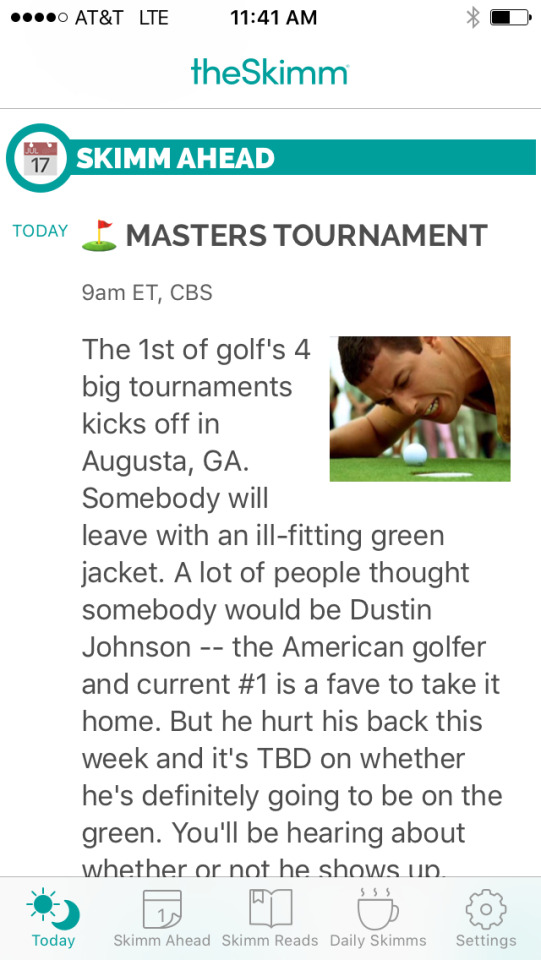
Unlike many other news sites, the Skimm has a big digital media preference from everything from celebrities Tweet about the Skimm to engaging quips on Instagram help the brand create awareness and gain traction.
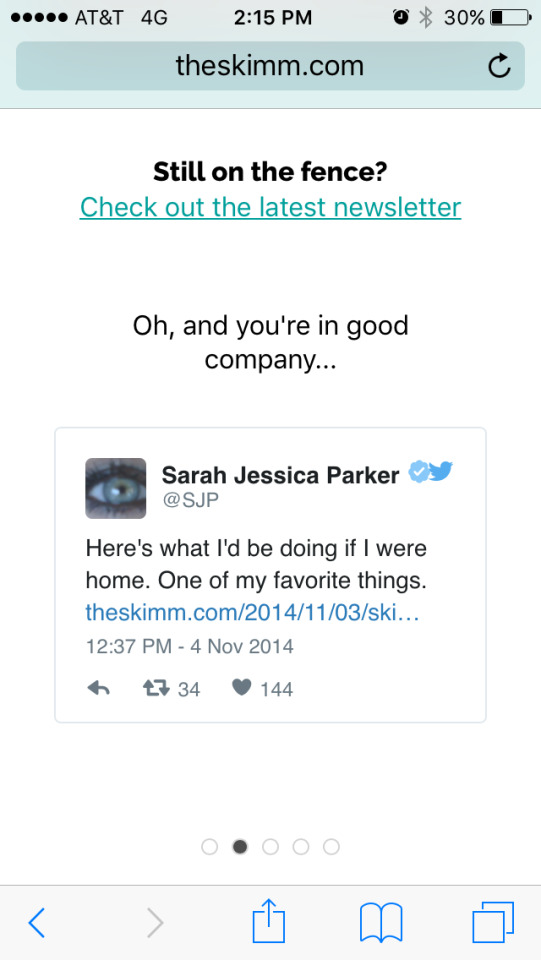
The Skimm is also unique in the fact that they have ‘Skimm’bassadors’ that allows fans to encourage others to join the following. As Skimm’bassdors spread the word and invite more people they receive accolades with even the opportunity to fly to New York and visit the Skimm office.
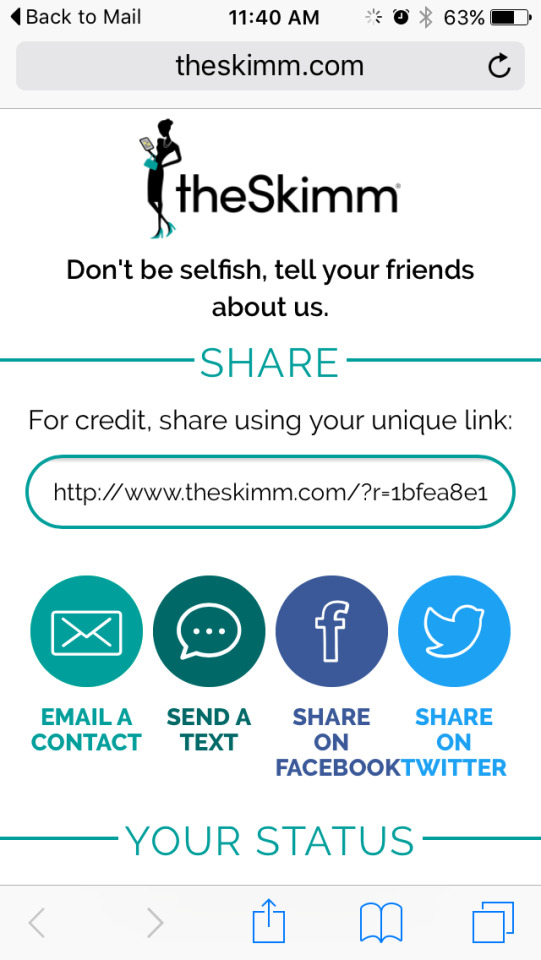
When it comes to advertisers, the Skimm is a prime opportunity. Eighty percent of their readers fall into the allusive demographic of women ages 22 to 34 who are successful. It can be a hard audience to reach and statistics show more than 1 million people a day are reading the Daily Skimm.[2] Instead of just using branding opportunities, they tie sponsorships into relatable content for their readers. For instance, the Daily Skimm is sponsored by Chase and while it includes a relatable graphic in line with the brand, it also includes an article under the Skimm Money section.
In a world where there is so much news it is nice to have a delivered digest that gets to the point, but has a feminine touch. The founders, former NBC news producers are onto something and it is apparent by the rapid growth and following. They are not at a Buzzfeed status yet, but nothing says they won’t get there.
[1] (2015. March 16). How Millennials Get News: Inside the habits of America’s first digital generation. Retrieved from https://www.americanpressinstitute.org/publications/reports/survey-research/millennials-news/. [2] Chafkin, Max. (2016. November 2). How the Skimm Became a Must-Read for Millennials. Retrieved from https://www.bloomberg.com/news/articles/2016-11-02/how-the-skimm-became-a-must-read-for-millennials.
0 notes
Text
News “Worthy”
In this day and age what is considered valuable news is increasingly becoming broadened to such a wide variety that I would say a majority of the news out there is anything but worthy. But if your news site name means worthy in Greek, you cannot do anything but deliver exceptional news. At least that is expectation when former Politico co-founder and other Politico staff members launched Axios in January 2017.

For much of 2016 Jim VandeHei’s departure from Politico was a mystery that is until he unveiled the launch of a new brand to address the negative perception the media has become in the public’s eye. According to Vanity Fair, the public’s trust in journalist has hit an all time low. VandeHei believes that news is split into established news sources, such as The Wall Street Journal and The New York Times, or sites just trying to get as much traffic to their site as they can. Axios is intended to be different, a site capitalizing on the fact we live in a time with access to more good information than ever before – but use different techniques to acquire the content and disseminate.
The site is broken into Top Stories, Technology, Politics, Business and Health Care.

While the site hones in on a few topics and provides to the point news, each page has a trending section with hot topics that have been trending within hours.
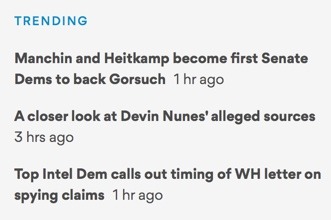
Of course, if browsing the site is not your thing – there is the option to subscribe to topic specific newsletters.
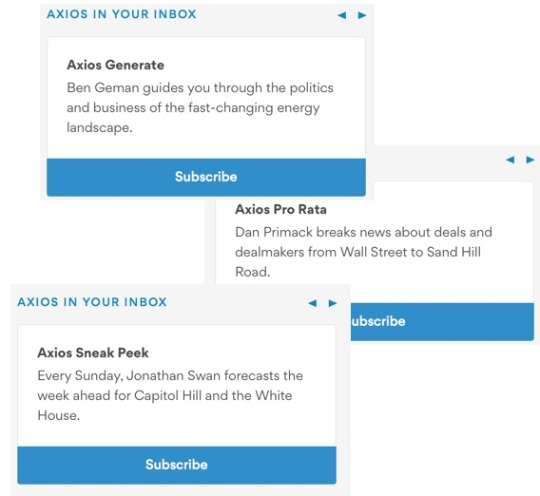
Overall, the site is a news site – dedicated to high-quality information with limited advertising. Throughout the site there are stories planted that are sponsored by brands and are stories about the brand. Sponsored brands include positive pieces about social responsibility and their employees.
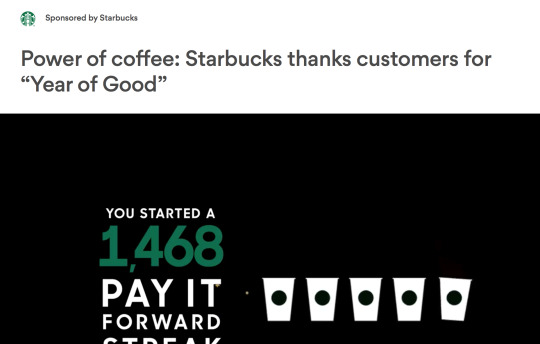
While the site is only in its third month since the official launch, it is a great way to get your topic specific news with limited advertising. I will be using the site for news, but more than anything I will be watching how it transforms in the coming month and where it is January 2018.
0 notes
Text
News on the Go
Since the widespread usage of cellular devices, life and habits have drastically changed. Consistently coming home to watch the evening news has become a thing of the past. Mobile access to news allows us to stay up-to-date in current events in real-time.
But with so many news sites at our fingertips, it can be overwhelming. Most news is delivered with opinionated commentary and lots of discussion. While that can be interesting, most of the time I just want the hard-hitting facts of the issue on several subjects to stay abreast of current events. Thankfully, I recently discovered that Reuters TV is exactly that – “mobile TV news service designed for on-the-go, informed, globally-minded consumers who don’t watch traditional TV news.”

Launched in 2015, Reuters TV has access to more than 2,500 journalists in more than 160 countries. It was created for an audience in their 30s or 40s with an appetite for to the point news, but don’t have the time for traditional news programs. According to the Managing Director of Reuters TV, Isaac Showman, “Reuters TV is news for the Netflix age: it’s individually relevant, on-demand, up-to date.”[1]
While it sounds like a pretty great way to get your news and stay in the know, I was concerned that the short daily news clips may not be that relevant to me. However, I quickly realized that the news programs are personalized news broadcasts that range from 5 to 30 minute segments comprised of clips based on my location, viewing history, viewing time and Reuters editors recommendations.
Research shows that on mobile devices, users spend an average of 12 minutes and on TV streaming devices an average of 21 minutes is spent. [1]
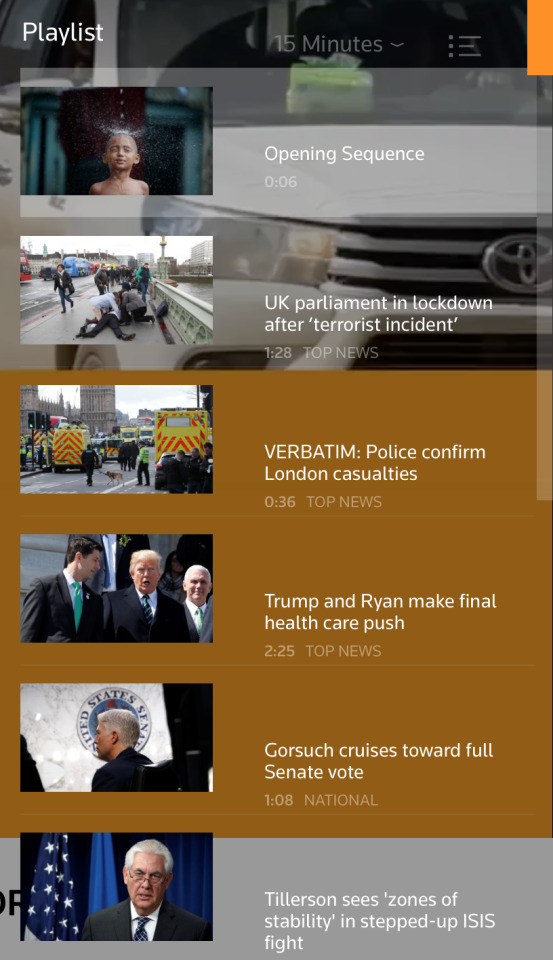
Every program has an opening sequence and a closing sequence with several news clips in between. The programming immediately starts with limited reporting from Reuters’ reporters. The clips included in the program range from breaking news to politics to economics to feel-good stories. Between some news stories a brief ad will appear that is 15 seconds or less.
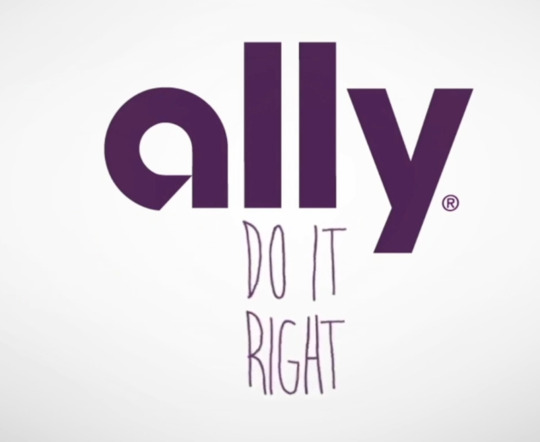
Initially, Reuters TV was launched with a 30-day free subscription followed by a minimal monthly fee to access. However, the subscription service changed in August 2015 to either charge a $2 monthly ad-free service to subscribe or a free subscription with ads. This changes resulted in massive growth with over a million monthly subscribers. According to Digiday, only a small fraction pays for the service, as the majority prefers the free ad-supported Reuters TV.[1]
Reuters TV provides advertisers the opportunity to reach audiences when they are engaged and limits the number of ads to ensure maximum attention is given to the 5 percent of ad viewing time that occurs during every program
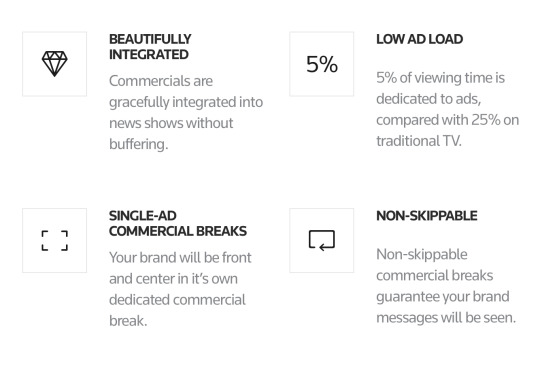
In the few days I have joined Reuters TV, I have found that it is a great source for on the go news, tailored for my busy lifestyle. Not only is the service great for viewers like me, it is also a good advertising platform for many brands. Research even shows that viewers prefer a free an advertiser-sponsored program over a paid, free-subscription service. Reuters TV has capitalized on the changing trends to provide news that has adapted to mobile lifestyles. In just over two years since its inception, it has seen massive growth - not only viewing the programs, but also watching where Reuters TV will take us in the future.
[1] Patel, Sahil. (2017. January 11). Reuters TV now has 1 million monthly viewers. Retrieved from https://digiday.com/media/reuters-tv-now-1-million-monthly-viewers/
[1] Patel, Sahil. (2017. January 11). Reuters TV now has 1 million monthly viewers. Retrieved from https://digiday.com/media/reuters-tv-now-1-million-monthly-viewers/
[1] Launder, B. & Woods, L. (2015. February 4). Introducing Reuters TV. Retrieved from https://www.thomsonreuters.com/en/press-releases/2015/02/introducing-reuters-tv.html
0 notes
Text
Battle of the Sexes.
We have made leaps and bounds to attain equality, but does that mean we want all of the same things? When it comes to our online information sources, it may not be the case. While many sites and publications are gender neutral, there are many sites dedicated to women or men – despite the fact the same percent of men and women read the news. According to MediaPost 54 percent of affluent men and women read news magazines, proving there is no gender skew. Even how we access our news has little variation between the genders, research shows men only spend a few more hours than women online a week.
Even though we are both reading news, Pew Research shows that there is a variance in the type of news that is most appealing between the genders. Women express more interest in stories pertaining to the weather, health, safety, natural disasters and tabloids; whereas, men show more interest in news stories centered on international affairs, politics and sports. (Talk about battle of the sexes, at least it makes sharing the morning newspaper easy.)
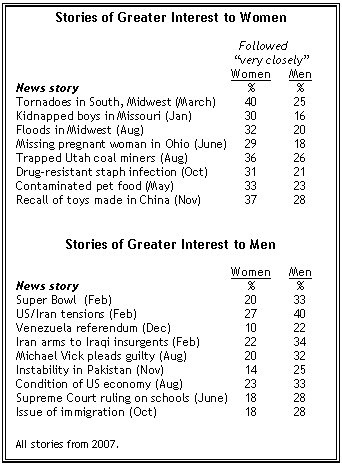
Gender neutral news sites are relevant as they present a variety of articles on a variety of topics that inform men and women. The sites provide ads that do not appeal to one gender over the other, but are ideal for brands that have products that serve both demographics. Sites specific to one demographic have an advantage of providing advertisers a targeted audience, which is perfect for brands with gender-specific products. Broadly Vice, Refinery29 and Huffington Post Women are some examples of online publications with sites dedicated to women. GQ and Huffington Post Men are online publications with sites dedicated to men.
Even though the sites are specific to one gender that doesn’t mean that they are exclusive. According to MediaPost, 20 – 30 percent of both genders read publications that are targeted at the opposite gender.
Despite the sites specific to women or men, people may not actually prefer segregated information. Research from O’Dwyers shows that women do not prefer gender specific advertising. In fact, almost 75 percent prefer gender-neutral ads.
There is not enough information to show that there is an overwhelming need for segregated sources of news based on gender. However, there will always be publications dedicated specifically to interests. This includes gender-specific sites that will provide advertising and stories targeted based on your demographic. If you want a more diverse sampling of information on a variety of topics and ads less related to lifestyle products, gender-neutral sites would be better for you. As for me, I think I like a balance of demographic based sites, as well as general sources of content is my ideal mix.
Sources:
Cole, M., & Kraus, S. (2013. October 2). Men, Women, And Media: United by Media, Divided By Content. Retrieved from http://www.mediapost.com/publications/article/207565/men-women-and-media-united-by-media-divided-by.html.
Pew Research Center, (2008. February 6). Where Men and Women Differ in Following the News. Retrieved from http://www.pewresearch.org/2008/02/06/where-men-and-women-differ-in-following-the-news/.
0 notes
Text
Is the Fall of Airline Loyalty Points the Rise of Print Magazine Subscriptions?
I can let my airline miles expire or pick up a print subscription to The Economist – of course I am going to select magazine subscriptions to The Economist, Wine Spectator, Travel and Leisure, and Food and Wine. Suddenly, at the fear of loosing my hard earned miles with no return value, I have become a consumer of printed magazines.
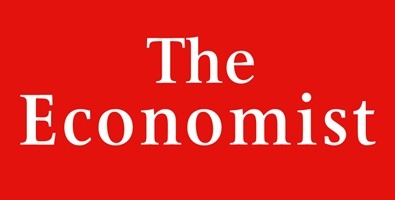
Is the decline in value for airline points the second coming of printed magazines? No. Lousy, loyalty programs no matter how much they deface the values of your miles will not establish a printed magazine comeback. Airlines are not the only ones offering print magazine subscriptions, popular subscription services, such as Fabletics, offer free magazine subscriptions with purchases.
Printed magazines are used for cross-channel marketing and I have taken a step-back in time with my new set of printed magazines. But is the marketing to consumers like myself causing printed subscriptions to overcome digital subscriptions?
According to David Pilcher from Freeport Press, “When it comes to our magazines, we read more, read longer and subscribe more often to print than digital.” Pilcher conducted a survey with a sample size of several hundred and concluded that Americans engage more with printed magazines versus digital. The survey results showed that less than half of Americans read print magazines, however, more Americans have print subscriptions rather than digital.
Just like the average American from the survey, I cannot remember the last time I read a digital magazine subscription. It is clear Americans are more likely to subscribe to printed versions of magazines. Fortune’s Matthew Ingram believes that online newspapers and publishers need to take into account that the average person will probably only pay for one online subscription, if even that.
The New York Times has been successful in attracting a million digital subscribers, which is an impressive feat. However, the revenue from digital magazines is minimal compared to the revenue from print circulation and print advertising. Print magazines are on the decline and the digital advertising revenue is struggling to make up the difference.
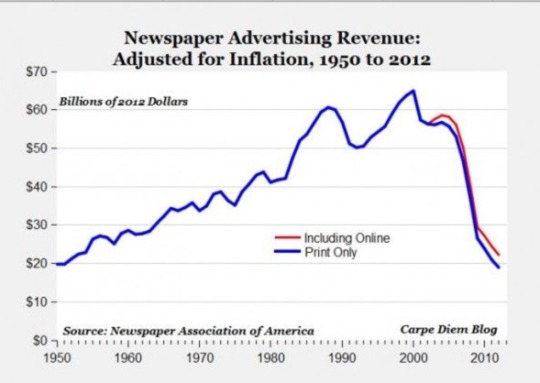
While publishers are failing to make up for lost print revenue with digital advertising and subscriptions, it doesn’t mean digital readership is down. Digital articles spark discussions, encourage interactivity, promote social sharing, create community, allow for ad space flexibility and provide forums for feedback. Digitally published articles have several social channels readily available for free marketing and awareness.
Free articles circulating online and a plethora of information readily available on social media, makes it difficult to convince consumers to purchase exclusive digital subscriptions. Additionally, advertisers have multiple online advertising spaces at their fingertips, which is why they are unwilling to pay premium advertising prices for content hidden behind subscription-only walls. The appeal of digital content is the ability to easily share articles across social media channels and increase engagement. Whereas a print subscription, doesn’t mean the magazine will be limited to an audience of one. Doctor’s offices and professional offices are some of the ways that a printed publication falls into the hands of many individuals.
Printed publications are on the decline, however, digital subscriptions are not the new print. Instead, free, accessible online articles may be the future.
Clearly print is not dead yet, as my new magazine subscriptions are slated to arrive soon, and give me an excuse to take a technological break.
Sources:
Pilcher, David. (2016. Aug 18). Print vs. Digital: How We Really Consume Our Magazines – 2016 edition. Retrieved from http://www.freeportpress.com/print-vs-digital-how-we-really-consume-our-magazines/.
Ingram, Matthew. (2015. Aug 06). Here’s what the New York Times’ 1 million subscriber number means. Retrieved from http://fortune.com/2015/08/06/new-york-times-paywall/.
Cruz, Daniel. (2014. Jan 23). Digital vs. Print: Which is Better For You?. Retrieved from http://associationmediaandpublishing.org/sidebar/Digital-vs-Print-Which-is-Better-For-You.
0 notes
Text
Staying Current without a Meltdown
The latest news on current events, trends, business, politics, food and health is everywhere. With so many sites segmented by topic it can be difficult to find a source that is representative of many subjects. Sure, Facebook is filled with articles you can read, but Facebook articles in my feed, unfortunately, are not of interest to me. Huffington Post and The Wall Street Journal have a variety of articles of topics on their sites, but I often find they are overly political. Recently, I head about Refinery29, and now I’m hooked.
Yes. The site has a massive header image at the top of the page that is an ad, but once you scroll past it – pure content on everything from video, fashion, beauty, living, health, entertainment, tech and news.
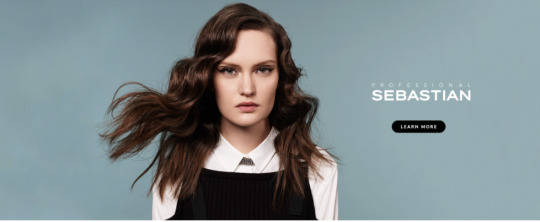
You can wander down the page clicking aimlessly on articles of interest or browse for articles by topic. (If you are worried that there is a lot to read and not enough time, check out Pocket to learn how to save articles for future reading.)
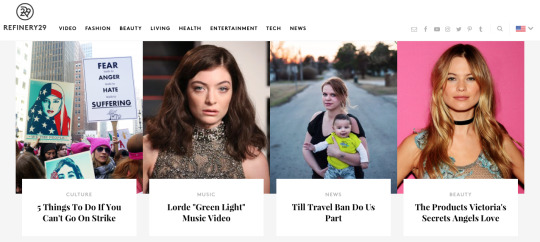
Of course, if you scroll too far down you are bound to see another ad that typically is the same brand as the header advertisement. The advertisements tend to change when you refresh the page. Considering the advertisements match and the design is clean and simple, the ads on the page feel more like content and less like an advertisement.
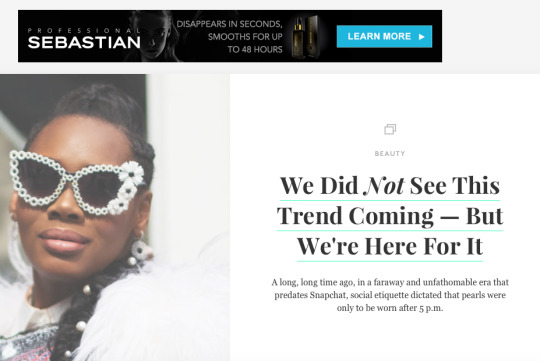
If going to the site everyday seems daunting, don’t worry you can sign up to receive daily news in your email. It is a daily selection of top articles on a variety of topics that link back to the site.
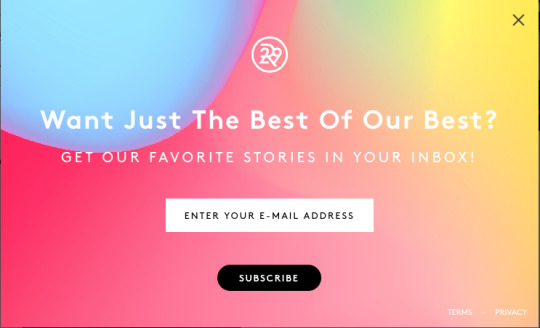
You can share on social media any of the articles you read or images from the articles.

There is also the option to contribute to a conversation about any of the articles on the site.
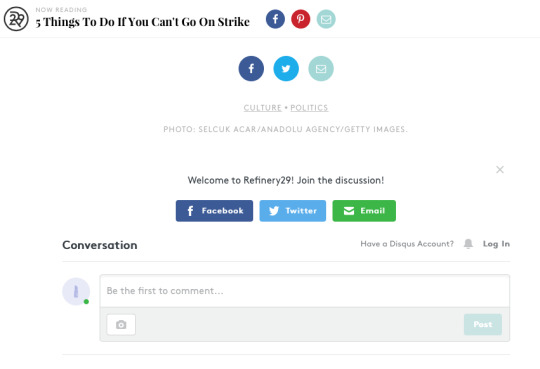
If you notice the site has been coded to display a static title of the article, making it easy to remember the title and share on social media. The site has been created to make it easy to read, share and find new articles. Even at the end of an article, if you keep scrolling there are more articles suggested to read – displayed in the same format as the home page.
Refinery29 started in 2005 with the goal of being a source of everything fashion, but has since expanded to include articles on a variety of topics. As of 2014, people spent more that 3.6 million hours on the site. However, despite the expansion, Refinery29 has stayed true to who they are with an emphasis on fashion. The site is not a complete replacement for current event content as other sites will continue to have information on the market and businesses, but it is a great primary site to use for anyone interested in fashion and beyond.
Source: http://www.corporate.r29.com/about/
0 notes
Text
Is there more to a list?
When I always think of a list, I think of to-dos or groceries. And neither of those lists give me any sort of joyous emotion. But top ten things trips to take in the summer, best restaurants in Dallas or top dog names of 2017 are all topics I can get interested in. Technically these are lists too, and thanks to The Office actor and Executive Producer BJ Novak, we now have the Li.st app where we can view almost any kind of list possible – except for groceries and to-dos.
I wasn’t ready to try Li.st just based on the idea of killing time by reading interesting lists, I already have other social media that fills up more than enough of my time. However, since I am going on some upcoming trips this spring, I decided to forgo Yelp and see if Li.st had some good tips on where to go and what to see. Within seconds the Li.st app was downloaded and available on my phone. A few pieces of information and I was ready, even with recommendations to get me started. Of course, if I was going to join it would make sense that I would follow Li.st co-founder, BJ Novak.
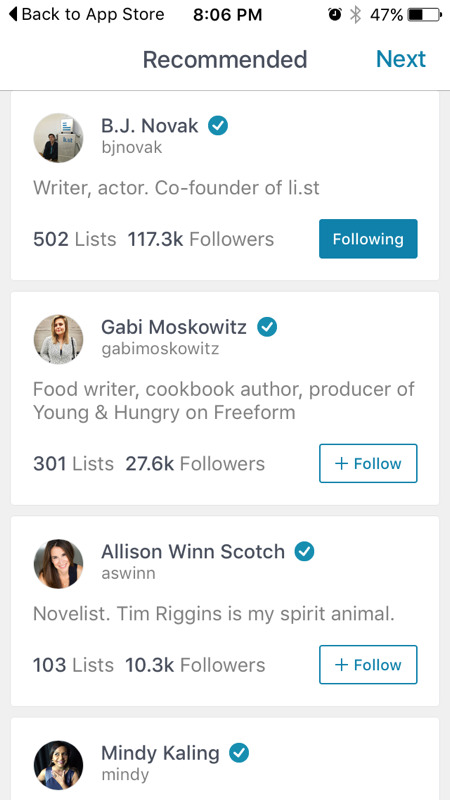
After choosing accounts to follow from my recommendations, I could select from my contacts. (If this post or previous posts have made you question my ability as a late adopter when it comes to social media – from the image below, you can see I am right at home with my social circle.)
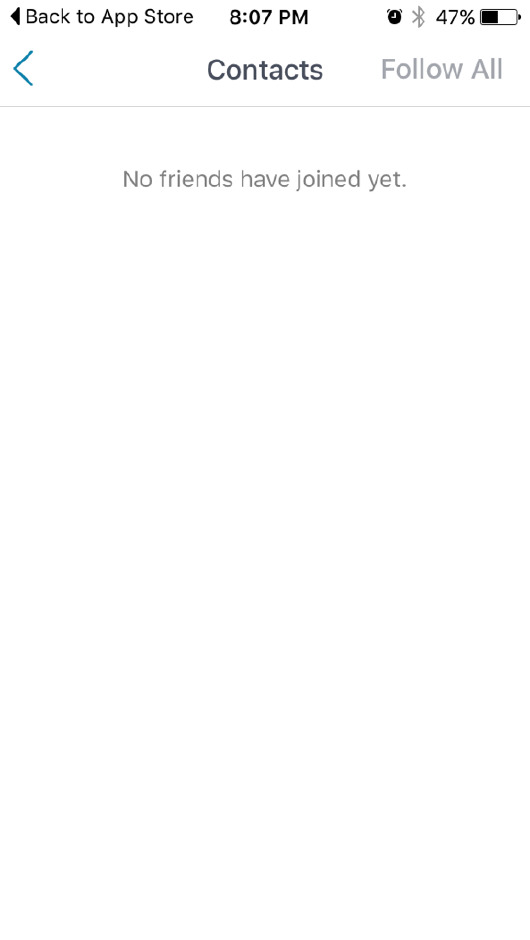
With a quick search based on topic, I could see multiple lists based on my search. Lists allow for comments, but some allow users to add their own suggestions to the list. They can be all text or a combination of text and images. Users build a following by posting engaging lists regularly. Avid fans can even receive notifications when their favorite user ads a new post.
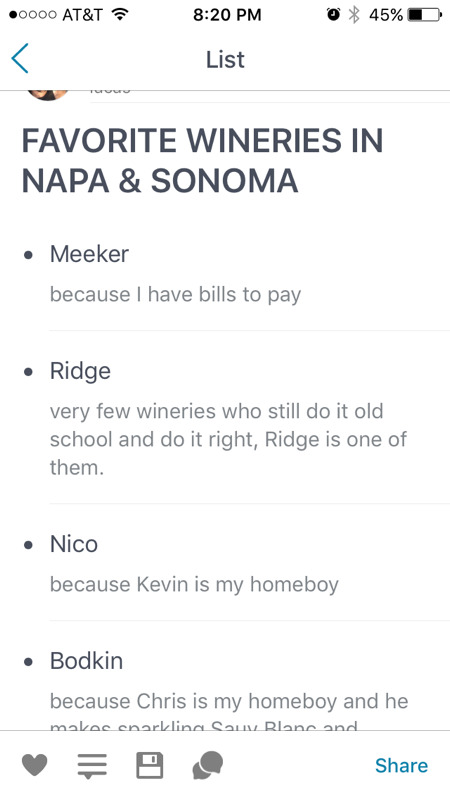
Users can easily add their list by selecting the pen and paper icon. But don’t worry if you are having a lapse of creativity, the app suggests possible lists you can create.
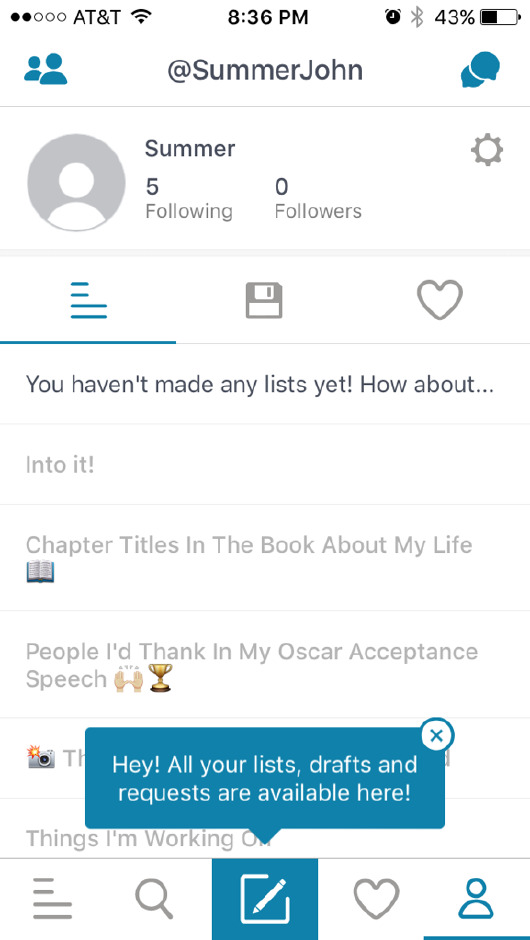
Li.st is a combination of tweets and blogs that comes in a mobile-friendly version where virtually anything can be a list. I am sure it is successful as the information is easy to read in seconds and is a concise way to deliver content. At the top of every list, users can write up to 350 characters about the list and each list item can have up to 500 characters.[i]
The List App, as it was formerly known, was launched in 2015, but was quickly relaunched in 2016 as Li.st. As of May 2016, there were over 150,000 users on the app who had created more than 250,000 lists. [ii] While the app is relatively new, it is a great platform for brands to consider for creating engaging content in list format to reach consumers. There are no branding opportunities for advertisers and the app still has a lot of room for growth. More users will add more content to the app, but the app will need to continue to generate more lists to attract more users. It can be a difficult cycle, but it will be interesting to see if it will hit widespread usage in the coming year.
As for me, I was able to get some tips for upcoming trips I would not have found without Li.st. I will definitely use it again in the future – for really anything I want a list.
[i] http://ew.com/article/2015/10/14/bj-novak-list-app/
[ii] Perez, Sarah. (2016. May 9). B.J. Novak’s “The List App” rebrands to li.st, arrives on Android. Retrieved from https://techcrunch.com/2016/05/09/bj-novaks-the-list-app-rebrands-to-li-st-arrives-on-android/
0 notes
Text
Fishbowl
“Conversations about work just got interesting”
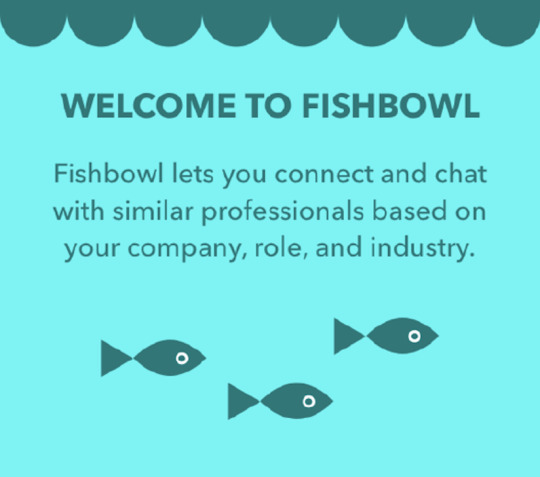
You have probably heard the term fishbowl to describe a small, managed group discussion, but you may not know it is also the name of a professional community group chat app. After many months of hearing, “sorry, I wasn’t listening, I was looking at Fishbowl,” from my boyfriend, I finally decided to check out this virtual water cooler for myself.
Downloading the Fishbowl app is the easy part, getting in is not as easy. Every user has to create a login on Fishbowl with their LinkeIn credentials. Fishbowl uses LinkedIn to confirm that users are professionals and they belong in the industry community. Every user is put into a community based on company and industry. (Making it impossible for cross-industry conversations.)
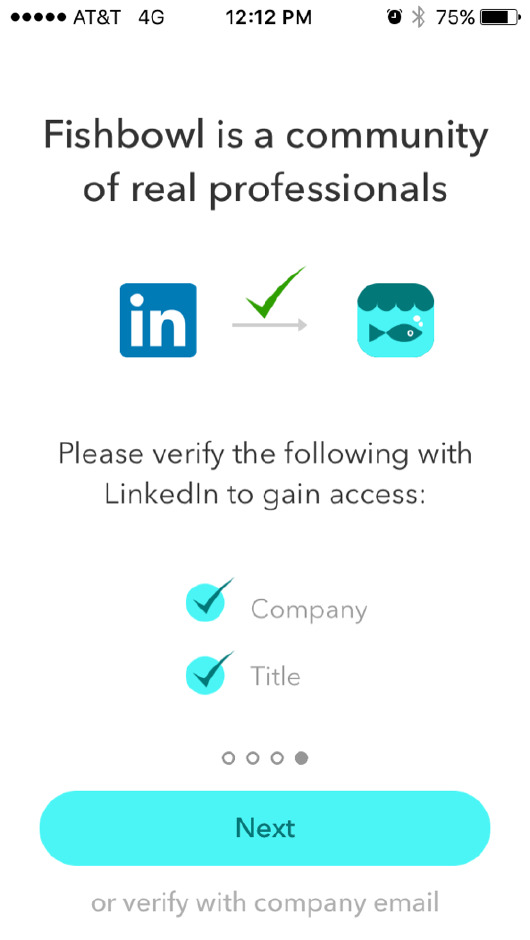
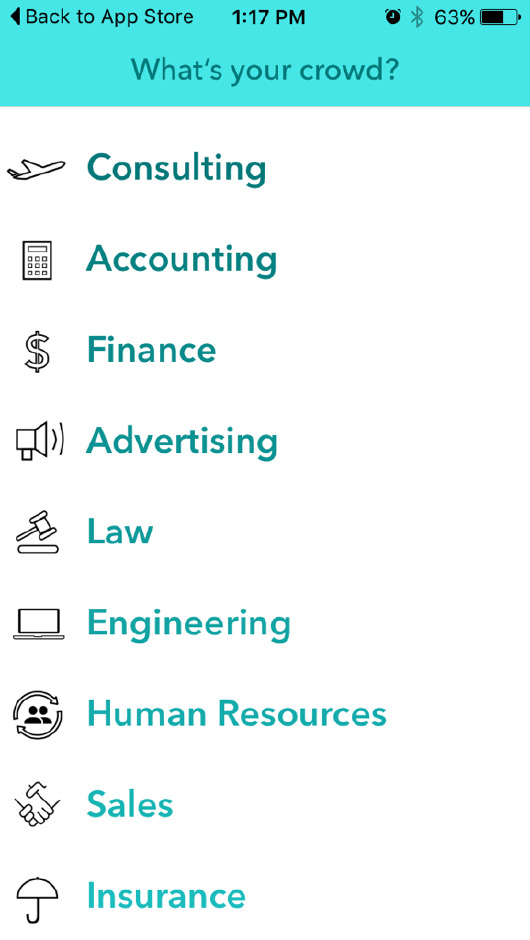
Once you create your login with LinkedIn, hold on, you’re not in yet! Most likely after creating your account you will be added to a waitlist. Community is vital at Fishbowl and they ensure every user fits their community standards. Once you finally are approved and receive your coveted account, you’re in. At the time of writing this, I was not ‘in’. Thankfully my boyfriend shared his Fishbowl login in for his consulting community.
Every user’s identity is concealed, as usernames are either the firm you work for or role (you decide how it will post). The first post in a discussion will just show that it was posted by someone at a certain company or role, such as EY, Project Leader, BCG, etc. Within that discussion each user who comments will then have a user name such as BCG 1, BCG 2, Analyst 2, etc. The number assigned is based on the sequence the individual from the company or role enters the discussion. It is easy to track conversations as EY 2 will remain as that user throughout the entire post, however in another discussion EY 2 could actually be EY 4.
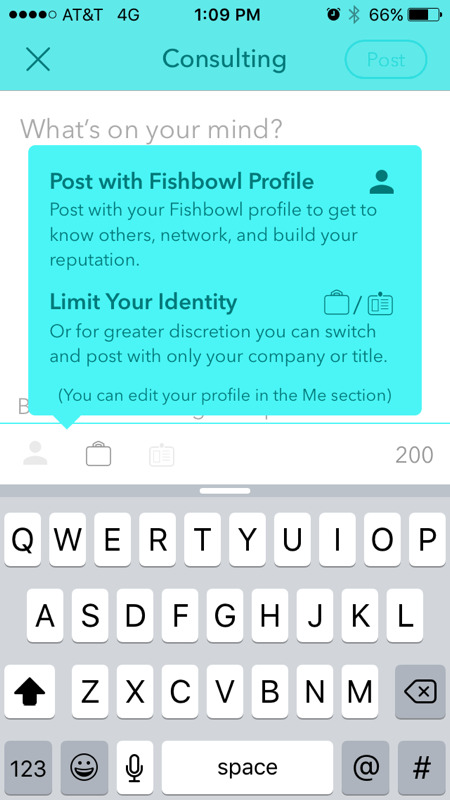
(Due to respect for the community, I will refrain from sharing any images of discussion.)
There are no ads on the app or any outside information. All the information is contained within the app based on peers in your industry. It is a place to ask information about competitors, learn about other companies in the industry, look for jobs, solicit advice from like-minded professionals, ask for job-related help, make industry associated jokes, share dating advice or even just talk about life. It is an anonymous work water cooler, where almost anything goes. However, it is also a large source of information related to a specific industry. Users can create their own discussions, comment on others or just follow along. Popular discussions with lots of votes or comments will appear at the top of the feed.
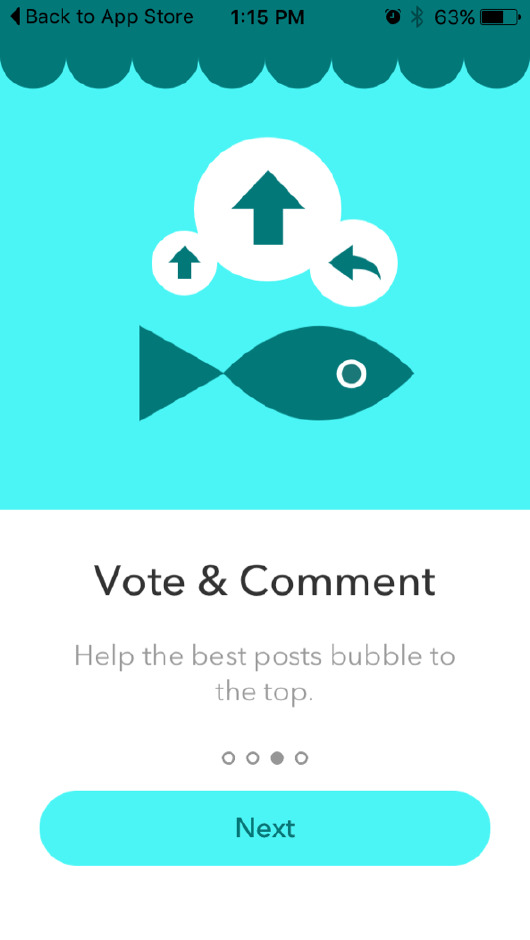
The company is fairly new and is privately owned, but it will be interesting to see if it grows and enters the space of branding opportunities or remains stagnant. With the app being private and limited users, it is difficult to find out statistics of how many users are in the community and how many different communities.
I can see how it is easy to get sucked in and spend hours reading what people are talking about. The anonymity of the app makes people speak freely about what is on their mind and what they want to know. It would be a marketers’ dream to analyze topic trends based on industry and further understand their target markets. But unfortunately it will just have to remain a dream for marketers and communicators alike…as I am still waiting for my invite to join the public relations group.
0 notes
Text
Pocket: Anywhere, Anytime

I always come across articles I want to read at a later time. For years I would copy links to my iPhone notepad, keep search tabs up or even use a pencil and paper to remind myself to go back and read the article. Of course, I would never read them as links were buried in the abyss of my smartphone notes, tabs would accidentally get closed and scratch papers would get lost.
My archaic way of storing articles changed this week when I discovered the ability to save articles and be able to access them anytime, even offline. (This is not a new feature, I am just really late to the party.) Pocket and Instapaper both offer the option to bookmark webpages and apps; articles striped of branding and ads; and access to content offline. While they both are free and similar, I selected Pocket as it offers a built-in social network feature to share content, unlike Instapaper.
Pocket is free but offers a premium subscription that provides the content even after a webpage is taken offline, as well as advanced search features. I settled with the free option since being able to effectively store webpages for later is already a huge step up for me.
Pocket provides an iOS and Android app, as well as a web browser that can be used to search for content through the pocket site. There is also the option to install a pocket link on your web browser tool bar that will save any page when you click on it. The app also offers to ability to store content from apps or mobile browsers.

Once you save an article, there is the option to tag it for easy search and categorization.
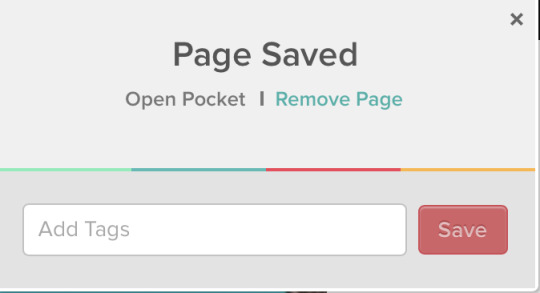
Pocket shows all of your saved pages, which you can read and delete, or save indefinitely.
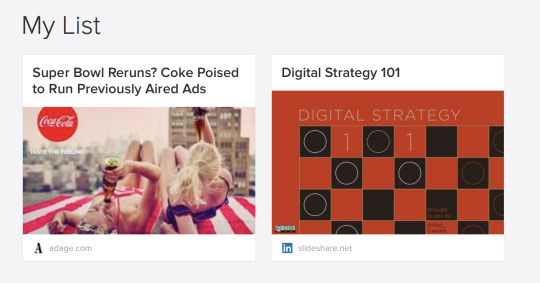
Based on your saved articles, Pocket will recommend other articles for you to read.
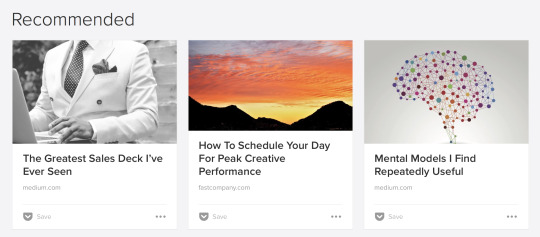
I don’t know if you took note where I previously mentioned that Pocket strips the article of the branding and ads. The original page source still appears in small print on the article, but all of the branding associated with the site is gone.
AdAge.com:
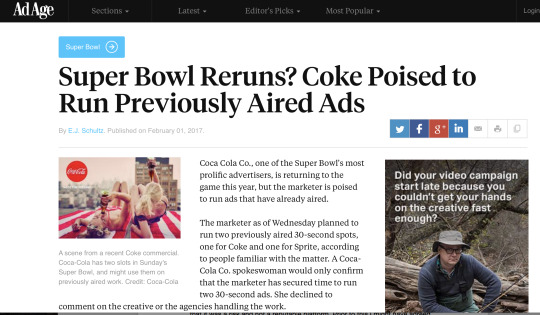
Pocket:
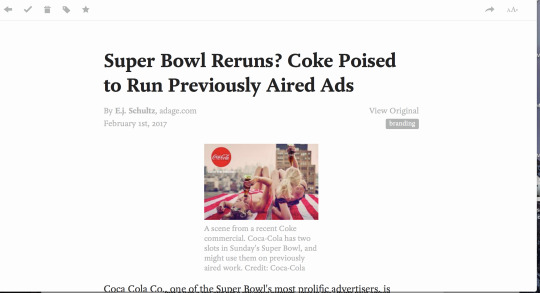
This is a great feature for readers, especially on mobile devices. Content within pocket without branding is in-line with a recent trend that is killing the hyperlink. Facebook is one example of a social media platform that is hosting articles from other sites internally and removing the link redirect. Internally hosted content is making social platforms the source of news. (If you want to read more about this, Fortune has a great article on this - http://fortune.com/2015/10/28/death-of-the-link/)
As you can see, I am not contributing to the death of the hyperlink.
Pocket striping articles of branding and ads is a huge loss for brands and advertisers. But the clean content does not mean it is devoid of ads. Pocket offers sponsorships, which is just a fancy way of saying advertising. Companies can pay to have their content and product natively woven into Pocket, and potentially reach content-driven consumers.
I am not sure I will be suggesting my company pursue sponsored ads on Pocket at this time, but I will continue using pocket to save articles. Of course, now I need someone to create a product to help me find time to read all of them.
Sources:
Ingram, Matthew. (2015, October 28). Facebook, Twitter and the death of the link. Retrieved from http://fortune.com/2015/10/28/death-of-the-link/
Klosowski, Thorin. (2016, January 31). Read It Later Showdown: Pocket vs. Instapaper. Retrieved from http://lifehacker.com/read-it-later-showdown-pocket-vs-instapaper-1756021479
0 notes
Text
#Inauguration

If you just returned to civilization after being stranded on a deserted island for years and somehow still haven't heard, this past Friday the 45th President of the United States of America was inaugurated into office. A momentous occasion in American history that has occurred every four years since 1789.
(Aside from those of you who just returned from the deserted island and are struggling to process what has taken place to the point of considering returning to the island) I am sure many of you wanted to watch another event in America’s history live.
Despite these historical moments, life does not stop for us to take time to watch live the swearing in of a new candidate, Phelps win his 28th Olympic medal, a new space mission take flight or even breaking news in Syria. My job is one of the parts of life that does not allow the time nor accessibility to watch such things. Just as I was accepting the idea of watching an inauguration recording later, I received an email associated with my rarely used Twitter account – PBS News Hour would be live streaming the inauguration. Exactly, what I wanted, a live opportunity to easily and discretely watch the live inauguration.
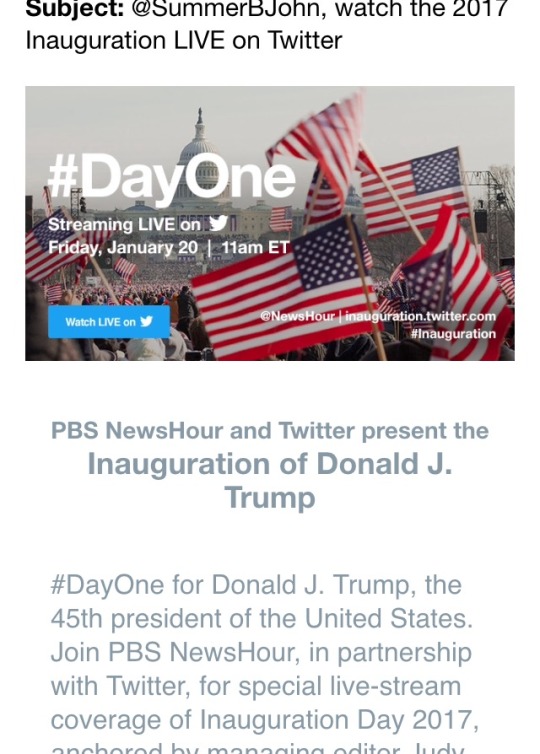
I immediately logged in to my Twitter mobile app and not only saw live coverage at PBS News Hour, but also saw Tweets from thousands of users commenting on the inauguration. The live portion of the app is succinctly organized so that you can view the video at the top of the screen and see a live comment feed below. (There is also the option to watch the video in full-screen, without the posts.)

While some Tweets were less desirable to read than others, many were informative and made the chat a source of information. For example, I would not have learned about the protests as they occurred live without the feed.
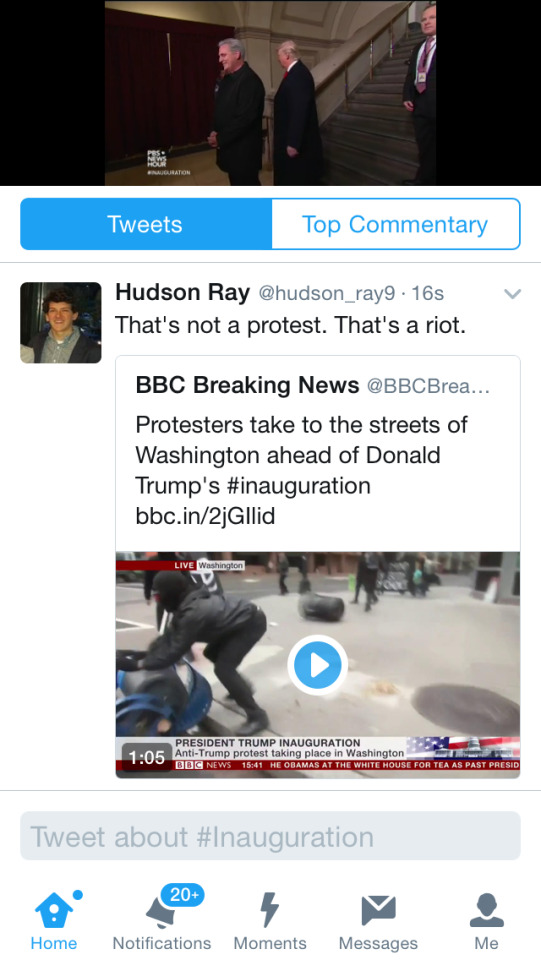
By using #inauguration and writing less than 140 characters, anyone could be part of the chat conversation. Within seconds posts from all over the world related to the inauguration were appearing for everyone to read, comment or re-Tweet.
While many Twitter users were also watching the live stream and adding to the conversation, so were many companies. Brands ranging from television news channels to printed news organizations to online journals were a part of the group providing content.
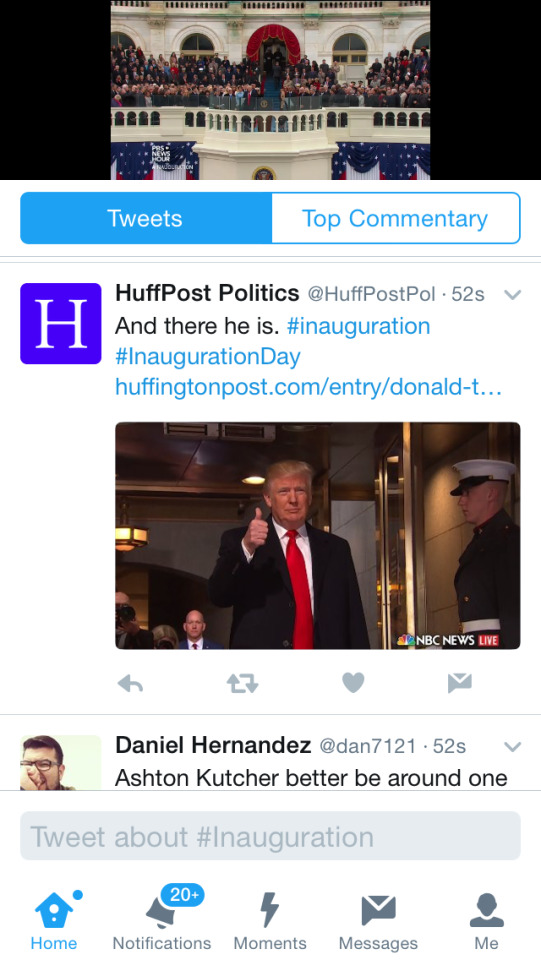
In addition to brands using the chat to share content tied to their brand, there was also an opportunity to pay for paid advertising to appear in the feed.
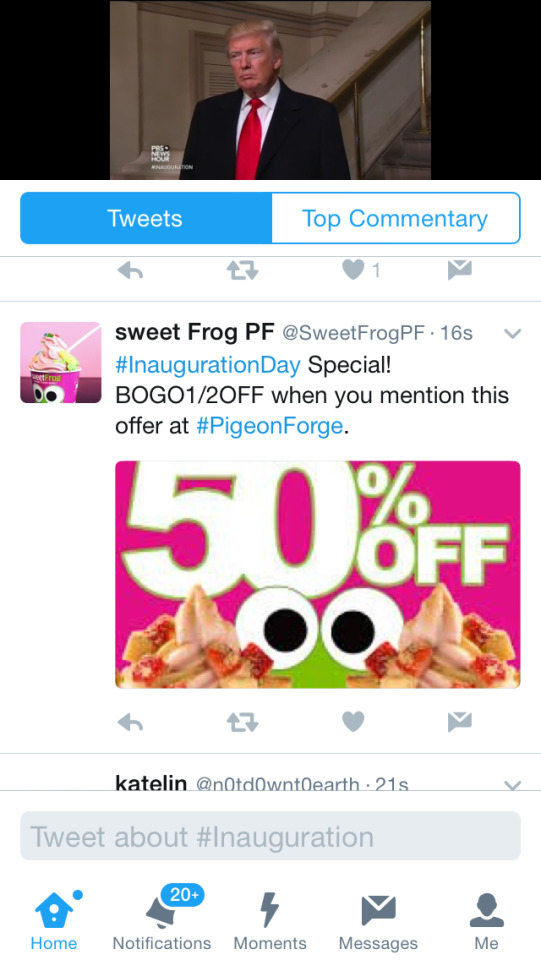
I don't have exact numbers for those who tuned in to watch the inauguration through Twitter, however, recent numbers show only 29.2 percent of American social media users are on Twitter. And of the 1.3 billion users with a Twitter account only 550 million have ever sent a Tweet. 24.6 percent of accounts are journalists and 83 percent of the world’s leaders are on Twitter.
Despite a low number of accounts sending Tweets, the average Twitter user follows 5 businesses. And research shows 77 percent of Twitter users feel more positive about a brand when a company responds to their Tweet, which probably explains why companies that use Twitter for customer service see a 19 percent increase in satisfaction.
With the number of businesses, media outlets and journalists using Twitter, it makes sense to use Twitter as not only a news source, but a live streaming one. I am so happy I learned about the live streaming of the inauguration. As for my job, the live event and chat feed was so interesting, I ended up putting work on hold to take a moment and enjoy history.
SOURCE:
Smith, Kit. (2016, May 17). 44 Twitter Statistics for 2016. Retrieved from https://www.brandwatch.com/blog/44-twitter-stats-2016/
0 notes
Text
Live News Through Snapchat Stories?
It’s true, Snapchat stories provide live updates through their user-driven content platform.
While I am a millennial (older millennial), I saw Snapchat merely as a tool to exchange photos and videos among friends. I knew the app could do more, but what exactly was unbeknownst to me. But that all changed during the Cowboys’ unsuccessful playoff game. I was going to view snaps of my friends at the game, when “Packers vs. Cowboys” under the live section caught my eye.
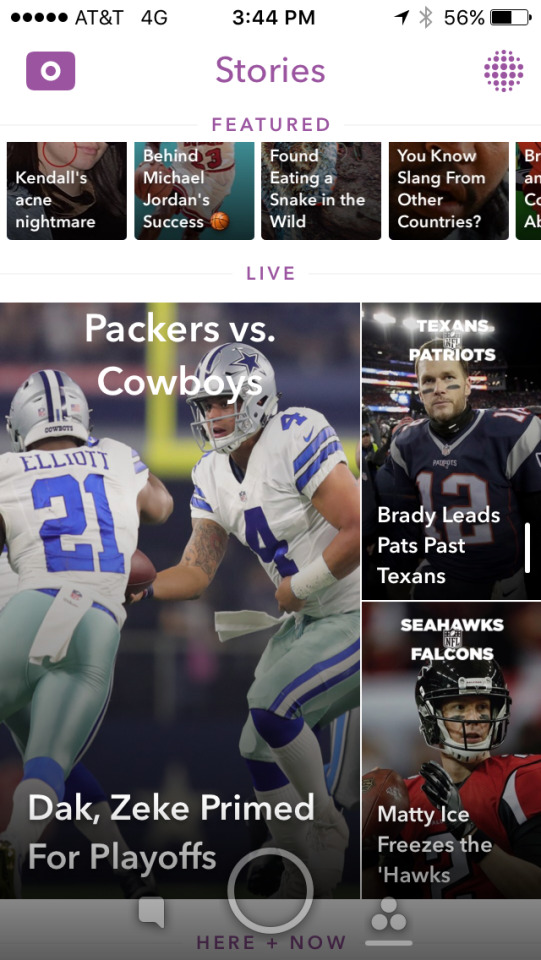
Instantly, I could see videos from the warm-up, the field, NFL employees and fans. And each clip even provided the up-to-date score of the game during the time of posting.

It is not surprising that you can get live news at your fingertips since 150 million people use Snapchat everyday. The interface is incredibly easy to use and within seconds anyone can add their clip to a public Snapchat story (after approval). Text or graphics, known as filters, can be added to any video or clip.
With 70 percent of all Snapchat users being millennials, it makes sense that the app is a prime opportunity for advertisers. According to Re/code ads are viewed on Snapchat anywhere from half a million to a million times a day. Of course with numbers like this, 22 percent of advertisers said in 2016 they would increase their advertising budget on Snapchat.
Ads are seamlessly placed within Snapchat stories between clips, lasting no longer than a typical user posted clip.
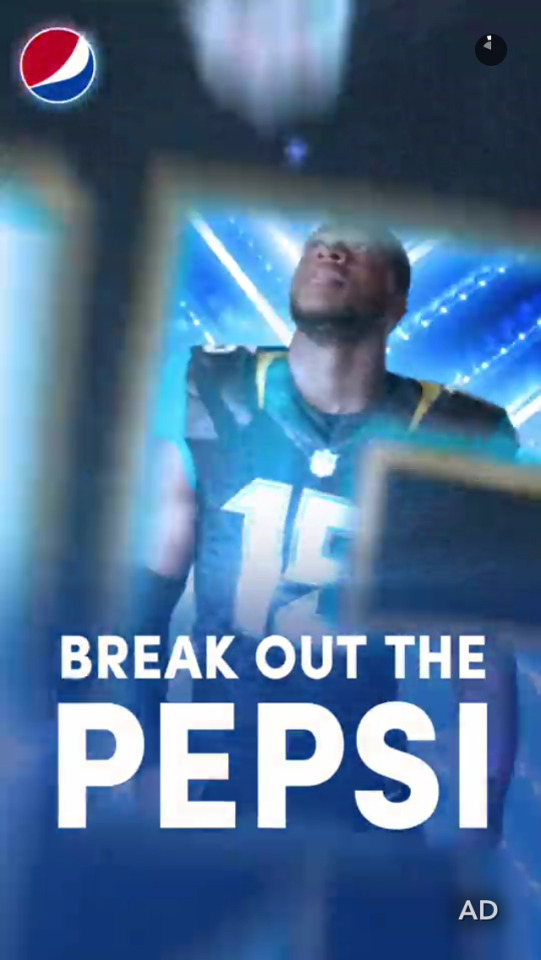
While the NFL was Snapchats’ first sports partner, it is not limited to sports. During Sunday’s playoff games, there was also a live story on healthcare protests and gatherings throughout the nation.

While user-driven content may not be 100 percent accurate, the ability to see live events from another person’s perspective and updates on current events is priceless. I think I may have found my new source of news, and sadly now that I taught my boyfriend my new discovery - he’ll probably be on Snapchat the next time an event falls during the big game!
Source:
The Snapchat Statistics Every Marketer Needs to Know. MediaKix, January 25, 2016. Accessed January 18, 2017. http://mediakix.com/2016/01/snapchat-statistics-2016-marketers-need-to-know/#gs.jFMCOS8.
0 notes